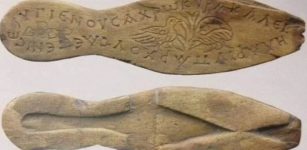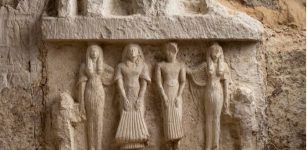Trajan’s Column – A Roman Triumphal Column In Ancient Rome
A. Sutherland - AncientPages.com - Pillars of victory, also known as memorial columns, were occasionally erected to memorize the triumphs of victorious achievements of an emperor.
They were built to honor an emperor and are generally described as a great victory because the Emperor won in the name of the Roman Empire. They thus acted as propaganda, which would show the Emperor's power to the citizens and secure his legacy.
Left: Column of Marcus Aurelius. Image credit: Marco Assini - CC BY-SA 2.0: Middle: The Column of Phocas, against the backdrop of the Arch of Septimius Severus. Image credit: Jebulon - CC0: Right: The Virgin Mary as the Immaculate Conception carrying a wreath of flowers offered annually by the Roman firemen. Sculpture by Giuseppe Obici on top of the Corinthian Column of the Pagan goddess Minerva. Credit: Monopoli91 - CC BY-SA 4.0
Today there are only a few ancient columns in Rome that survived until our time, for example, the Column of the Immaculate Conception, the Column of Phocas added to the Forum Romanum, an impressive Column of Marcus Aurelius - War Monument From Ancient Rome. Still, Trajan's Column remains the most famous of them.
Even before the imperial era, generals and senators had praised their own more or less heroic deeds by building triumphal arches.
In 113 AD, Emperor Trajan chose something else and instead built, possibly because he wanted to distinguish himself from his predecessors and even recalled by future successors.
The 35 meters (98 feet) in height, massive victory column has always impressed people, and in fact, it still does). A 190-meter-long frieze, ringing 23 laps around the Column, describing Trajan's two victorious military campaigns in Eastern Europe during the Dacian Wars (101-102 AD and 105-106 AD) contributed to its popularity.
The structure is additionally decorated with a large pedestal, ornamented with sculptured trophies on three sides.
The sculpture is one of the most spectacular works of artisans and builders and includes more than 2,500 human figures, besides animals. The artwork of the ancient Roman artists was intended to illustrate the most significant incidents of Trajan's war with the Dacia.
The whole frieze is not visible from the ground, but it was surrounded on three sides by two flanking libraries and the Basilica Ulpia. Among several spectacular features of the Column is a bas-relief that spirals 23 times to the top of the Column.
One of the fascinating features of the monument is the bas-reliefs that depict scenes from the Dacian Wars.
The reliefs that adorn the Column constitute a continuous – approximately 200 meters long frieze that spirals twenty-three times around the shaft, beginning at the bottom with scenes depicting preparation and departure that anticipate the first Dacian campaign of Emperor Trajan.
Trajan's Column, Rome. Image credit: Carole Raddato - CC BY-SA 2.0
No modern equipment was used to build this Column; however, the ancient Romans managed to create many such high structures with the help of using cranes.
The shaft is made from 20 gigantic white or blue-grey marble drums, each weighing approximately 32 tons, with a diameter of 3.7 meters (12.1 feet). Inside the shaft, a spiral staircase of 185 steps provides access to a viewing platform at the top of the Column.
The top block of Trajan's Column weighs 53.3 tons (the heaviest of all), which had to be lifted to a height of approximately 35 meters (115 feet) in the air.
Trajan's column in Rome. Credit: Alvesgaspar- CC BY-SA 4.0
The Italian master builders successfully lifted this gigantic "piece "of stone, and it still stands today. The construction made a great impression on contemporaries, and later emperors began to build their victory columns. Many of them were destroyed with time, but Trajan's famous masterwork survived almost intact. Today it is only missing its original painted decoration, the metal attachments that added detail to the carved figures, and the great bronze statue of the Emperor himself that once crowned the top of the Column. Later, in December 1587/1588, Pope Sixtus replaced the statue of Emperor Trajan himself with that of St. Peter, which remains until today.
The chief architect responsible for the spectacular design of the Trajan's Column was Apollodorus of Damascus. He was the Emperor's favorite and most appreciated engineer and architect, widely known for his other notable building projects in the Roman Empire, such as the Danube Bridge, the first bridge to be constructed across the Danube and a significant feature during the Dacian Wars, among others.
The Trajan's Column (a symbol of glorification) would show the Emperor's greatness and tell a story about successful military encounters.
Most of all, the Column was and is still considered an engineering marvel of the Roman builders due to the immense excavation efforts necessary for its construction.
Updated on June 11, 2022
Written by – A. Sutherland - AncientPages.com Senior Staff Writer
Copyright © AncientPages.com All rights reserved. This material may not be published, broadcast, rewritten or redistributed in whole or part without the express written permission of AncientPages.com
Expand for referencesReferences;
Kalas G. The Restoration of the Roman Forum in Late Antiquity
MacDonald W. L. The Architecture of the Roman Empire
Beckmann M. The Column of Marcus Aurelius
More From Ancient Pages
-
 Human Activities In The Year 1300 Impacted Earth’s Atmosphere More Than Previously Known
Archaeology | Oct 9, 2021
Human Activities In The Year 1300 Impacted Earth’s Atmosphere More Than Previously Known
Archaeology | Oct 9, 2021 -
 A Scientific Surprise: Bering Land Bridge Formed Late During Last Ice Age
Archaeology | Dec 27, 2022
A Scientific Surprise: Bering Land Bridge Formed Late During Last Ice Age
Archaeology | Dec 27, 2022 -
 On This Day In History: The Battle of Blore Heath – Sep 23, 1459
News | Sep 23, 2015
On This Day In History: The Battle of Blore Heath – Sep 23, 1459
News | Sep 23, 2015 -
 Ancient Maya Lessons On Surviving Drought – Examined By Scientists
Archaeology | Jan 5, 2022
Ancient Maya Lessons On Surviving Drought – Examined By Scientists
Archaeology | Jan 5, 2022 -
 Ancient Sahul: Its Submerged Landscapes Reveal A Mosaic Of Human Habitation
Archaeology | Dec 26, 2023
Ancient Sahul: Its Submerged Landscapes Reveal A Mosaic Of Human Habitation
Archaeology | Dec 26, 2023 -
 How Did Indus Civilization Manage To Resist Climate Change?
Archaeology | Feb 22, 2017
How Did Indus Civilization Manage To Resist Climate Change?
Archaeology | Feb 22, 2017 -
 Cosquer Cave And Its Magnificent Underwater Stone Age Paintings Created 27,000 Years Ago
Featured Stories | Apr 20, 2021
Cosquer Cave And Its Magnificent Underwater Stone Age Paintings Created 27,000 Years Ago
Featured Stories | Apr 20, 2021 -
 Before The Pharaohs: The Evidence For Advanced Civilization In Egypt’s Mysterious Prehistory
Civilizations | Apr 14, 2017
Before The Pharaohs: The Evidence For Advanced Civilization In Egypt’s Mysterious Prehistory
Civilizations | Apr 14, 2017 -
 New Insights Into The Dawn Of The Indo-European Languages
Linguistic Discoveries | Jul 27, 2023
New Insights Into The Dawn Of The Indo-European Languages
Linguistic Discoveries | Jul 27, 2023 -
 Unique Headstones Of Kela Mazin Cemetery In Kurdistan Are Probably 3,000 Years Old Or Much More
Archaeology | May 7, 2022
Unique Headstones Of Kela Mazin Cemetery In Kurdistan Are Probably 3,000 Years Old Or Much More
Archaeology | May 7, 2022 -
 Secrets Of Quipu – One Of The Most Mysterious Phenomena That Existed In Odd Number Of Dimensions
Featured Stories | Feb 9, 2015
Secrets Of Quipu – One Of The Most Mysterious Phenomena That Existed In Odd Number Of Dimensions
Featured Stories | Feb 9, 2015 -
 World’s Oldest Dictionaries Are 4,500-Year-Old Cuneiform Tablets Discovered In Ebla
Ancient History Facts | Aug 19, 2016
World’s Oldest Dictionaries Are 4,500-Year-Old Cuneiform Tablets Discovered In Ebla
Ancient History Facts | Aug 19, 2016 -
 Giant 4,500-Year-Old Axe Grinding Site Discovered In Scotland
Archaeology | Dec 13, 2022
Giant 4,500-Year-Old Axe Grinding Site Discovered In Scotland
Archaeology | Dec 13, 2022 -
 A Remarkably Well-Preserved Wooden Well Dating Back To The Bronze Age Uncovered In Benson, Oxfordshire
Archaeology | May 10, 2024
A Remarkably Well-Preserved Wooden Well Dating Back To The Bronze Age Uncovered In Benson, Oxfordshire
Archaeology | May 10, 2024 -
 Silla: The Most Successful Of Three Korean Kingdoms
Featured Stories | Aug 22, 2023
Silla: The Most Successful Of Three Korean Kingdoms
Featured Stories | Aug 22, 2023 -
 Byzantine Sandals With A Nice Message Found In The Harbor Of Eleutherios (Theodosius) – Now On Display
Artifacts | Apr 12, 2023
Byzantine Sandals With A Nice Message Found In The Harbor Of Eleutherios (Theodosius) – Now On Display
Artifacts | Apr 12, 2023 -
 Impressive Ancient Underground Tombs And Chapels Unearthed In Saqqara, Egypt
Archaeology | Apr 16, 2023
Impressive Ancient Underground Tombs And Chapels Unearthed In Saqqara, Egypt
Archaeology | Apr 16, 2023 -
 Anartes: Forgotten Celtic Tribe And The Hercynian Forest With Strange Animals
Featured Stories | Jun 18, 2024
Anartes: Forgotten Celtic Tribe And The Hercynian Forest With Strange Animals
Featured Stories | Jun 18, 2024 -
 Streets Of Ancient Rome Were Very Dangerous
Ancient History Facts | Feb 29, 2016
Streets Of Ancient Rome Were Very Dangerous
Ancient History Facts | Feb 29, 2016 -
 Deeper Look Into Chinese Swords Throughout The History Of The Dynasties
Featured Stories | Sep 19, 2018
Deeper Look Into Chinese Swords Throughout The History Of The Dynasties
Featured Stories | Sep 19, 2018



